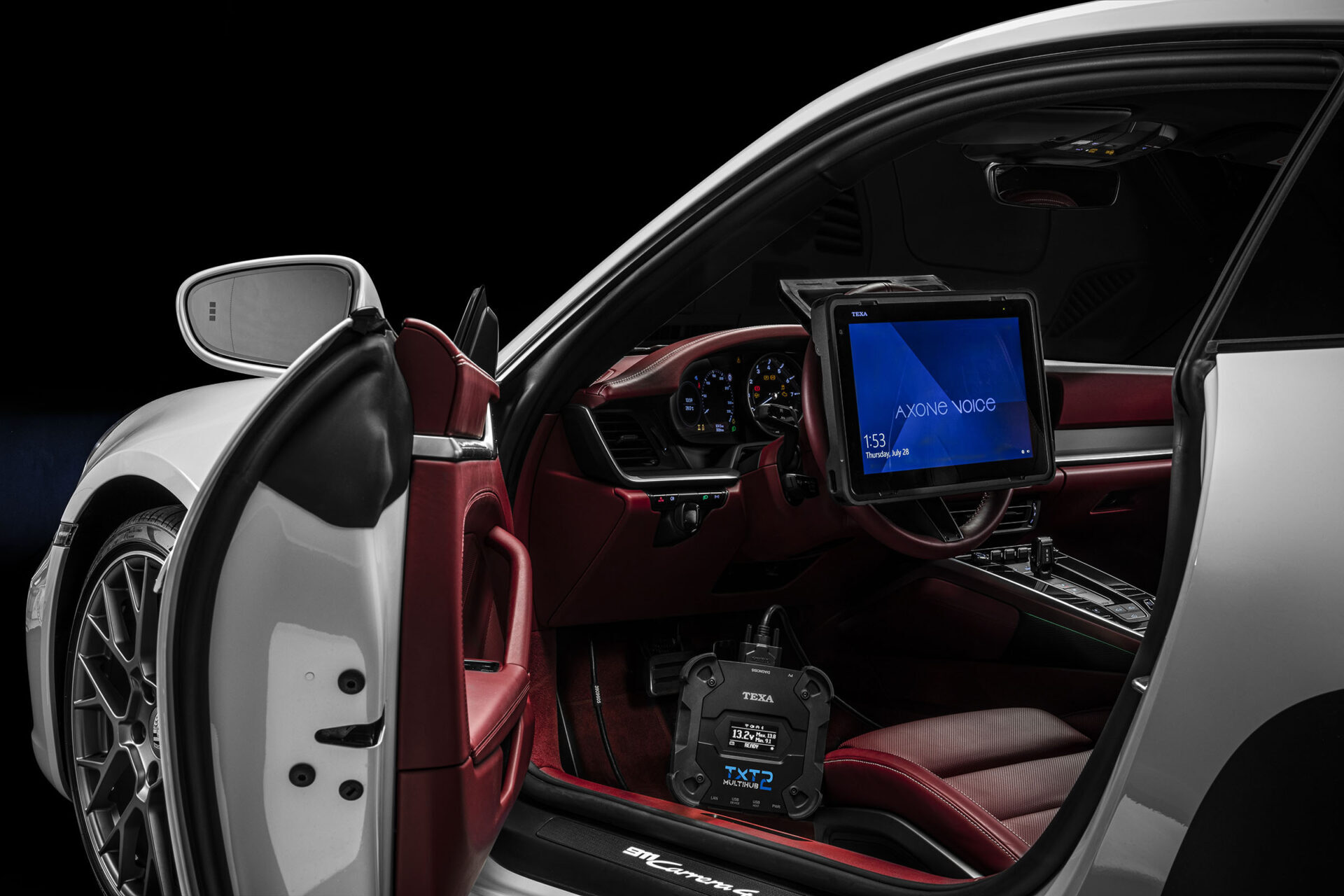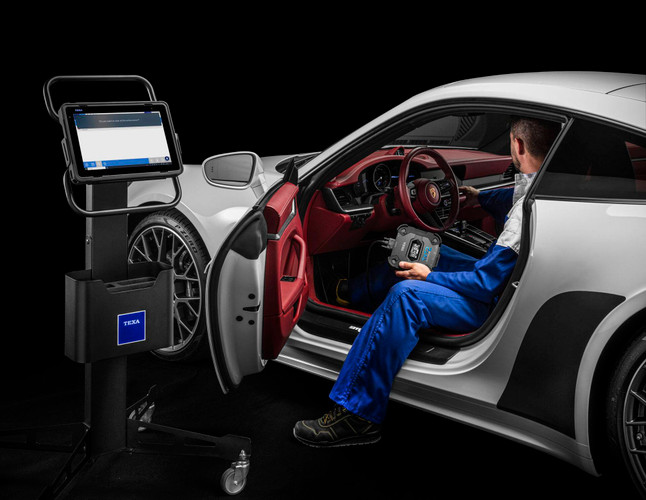[Image by TEXA linked to their website via https://www.texa.com/products/axone-voice/]
When most technicians think about ADAS calibration, they picture everyday vehicles—Honda Accords, Ford F-150s, or Toyota Camrys. But there's a growing segment of the market that presents unique challenges and opportunities: supercars. Ferrari, Lamborghini, McLaren, and Rolls Royce vehicles are increasingly equipped with sophisticated driver assistance systems that require specialized knowledge and proper calibration equipment.
The Hidden Complexity of Exotic ADAS Systems
Modern supercars aren't just about raw horsepower anymore. A 2024 Ferrari equipped with adaptive cruise control, lane departure warning, and automatic emergency braking represents millions of dollars in research and development. These systems must function flawlessly at speeds that would challenge any safety technology, making proper calibration critical.
Consider this scenario: a Ferrari owner brings their vehicle in after a minor collision that required windshield replacement. That forward-facing camera isn't just monitoring traffic—it's designed to function at triple-digit speeds(!) while managing systems that can mean the difference between life and death. A camera that's even slightly misaligned could cause the automatic emergency braking system to activate too late or fail to detect obstacles properly at the extreme speeds these vehicles are capable of reaching.
The stakes are higher, the tolerance for error is smaller, and the expertise required goes well beyond standard automotive repair. Vehicle safety standards for these exotic machines are confirmed through precise calibration procedures that ensure every sensor functions within exact manufacturer specifications, maintaining the safety certifications these vehicles were originally designed to meet.
The Aftermarket Gap
Here's where many shops hit a wall. Traditional aftermarket diagnostic tools often treat supercars as an afterthought, if they cover them at all. The few tools that do offer exotic coverage typically require expensive additional modules or separate subscriptions that can cost thousands of dollars annually.
Even when coverage exists, it's often incomplete. A shop might be able to read basic codes from a Lamborghini but lack the bidirectional controls needed for proper ADAS calibration. This forces customers to return to dealerships for even routine maintenance, creating missed revenue opportunities for independent shops.
Furthermore, many of these owners of exotics have a high willingness to pay, yet are faced with few options for aftermarket service. The supply-demand favors those who are able to serve these owners.
TEXA's Comprehensive Approach

[Image by TEXA linked to their website via https://www.texa.com/products/axone-voice/]
TEXA took a fundamentally different approach to supercar coverage. As Dario Peruch, Managing Director of TEXA USA, explains, their coverage extends to "Ferrari, Lamborghini, McLaren, and Rolls Royce vehicles"—with full ADAS calibration capabilities included. This isn't basic code reading; it's comprehensive diagnostic and calibration functionality that matches OEM capabilities.
The company's supercar package represents a one-time $1,500 upgrade that provides lifetime access to exotic vehicle coverage. For shops purchasing TEXA's flagship Axone Voice system at $9,300, this upgrade is included at no additional cost, making it an exceptional value proposition.
Check out the full capabilities of TEXA’s Axone Voice.
What sets TEXA apart is their collaborative relationship with these manufacturers. Rather than reverse-engineering systems from the outside, TEXA works directly with companies like Lamborghini and the Fiat Group to develop their diagnostic capabilities. This partnership approach ensures deeper, more reliable coverage that actually works in real-world situations.
Real-World Impact
A recent customer interaction illustrates the power of proper supercar coverage. A shop specializing in Ferrari maintenance was evaluating diagnostic options when they discovered TEXA's comprehensive exotic vehicle capabilities. The customer's immediate response was telling: "Literally his words were like, okay, here's my credit card, let's go."
This reaction speaks to a common frustration among shops working with high-end vehicles. When you find a tool that actually provides the coverage and functionality you need, the decision becomes obvious. The alternative—turning away lucrative supercar work or dealing with incomplete diagnostic capabilities—simply isn't viable for shops serious about serving this market.
The Digital Advantage
TEXA's ADAS calibration approach provides particular advantages for supercar work. Their RCCS3 system uses a 75-inch high-definition display to project digital calibration targets, eliminating the need to source and store exotic-specific physical targets that might be used only occasionally.
When a new supercar model requires a previously unseen calibration target, TEXA customers receive it through software updates rather than having to order, stock, and potentially lose expensive physical targets. For shops working on low-volume, high-value vehicles, this efficiency improvement can significantly impact profitability.
Beyond the Tool: Support That Understands
Working on supercars requires more than just having the right equipment—it demands expertise and support when unusual situations arise. TEXA's technical support team consists entirely of former mechanics who understand both the technical challenges and the customer service expectations that come with exotic vehicle work.
This support becomes invaluable when dealing with vehicles that might represent someone's dream car or significant financial investment. The ability to have expert guidance available during complex procedures provides confidence that's essential when working on six-figure automobiles.
The Business Case
For shops considering whether supercar coverage justifies the investment, the math is compelling. A single ADAS calibration on an exotic vehicle can command premium pricing that quickly recovers the upgrade cost. More importantly, having proper diagnostic capabilities opens doors to ongoing service relationships with high-value customers who typically generate significant lifetime revenue.
The alternative—referring supercar work to dealers or competitors—represents not just lost immediate revenue but missed opportunities to build relationships with customers who often own multiple high-end vehicles and aren't price-sensitive when they receive quality service.
Plus, it’s a motivator for your staff, who can be proud to work on supercars.
Setting New Standards
TEXA's approach to supercar ADAS coverage reflects a broader commitment to comprehensive diagnostic capabilities rather than market segmentation. By treating exotic vehicles as an integral part of their platform rather than an expensive add-on, they've created a tool that can handle whatever drives through the shop doors.
In an automotive landscape where ADAS systems are becoming standard across all vehicle segments—from economy cars to hypercars—having diagnostic capabilities that scale across the entire market represents both practical efficiency and significant competitive advantage.
The future of automotive service lies in comprehensive capabilities rather than market limitations. Check out TEXA’s innovative diagnostic scan tools.

